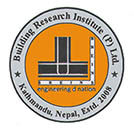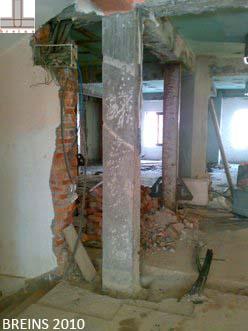
Today (NST)
Monday, Jun 16, 2025
Smart Search
Please post in your Technical Queries, Comments & Suggestions to Contact us......
Advertisement

For Advertisement
|
|
| Subscribe to BREINS Sci-Tech |
| Visit this group |

Seismic Retrofitting
What does Seismic Retrofitting mean?
Seismic Retrofitting, primarily meant to enhance the safety of the existing structures in earthquakes; is an effective application of Structural Engineering. Following describes the step by step definition/procedure regarding Seismic Retrofitting of various kinds of structures;
Selection of the Proper Retrofitting Measure
Retrofitting Design Principles
It is the method of strengthening of the already built damaged/undamaged old/new structures those are found to be weak in earthquake loadings that may occur in future.
Generally, structures vulnerable to earthquakes are retrofitted by means of Steel jacketing, Concrete jacketing, Galvanized steel mesh reinforcement, Inclusion of new Supporting walls / Concrete shear walls, Steel bracings, Fiber Reinforced Polymer (FRP) sheets or by any other suitable means. Please refer http://buildingresearch.com.np/seisretro.php for retrofitting measures available.

Fig-1 (Seismic Retrofitting Works on a Six Storeyed Non Ductile RC Frame Building by BREINS - Building Research Institute (P) Ltd., Nepal, 2010)
Retrofitting works may also be necessary in a well built building if extra storeys are to be added. Also, old-weak buildings can be extended after properly strengthening the older part so as to bear the increased safety demand due to the extended part.
Selection of the Proper Retrofitting Measure
Proper study of the existing structure using various analytical tools need to be carried out to identify the weak zones within the structure prior to carrying out retrofitting works. It also helps in the selection of proper retrofitting measure that should be adopted in terms of economic and safety aspects.
Building structures lying in acceleration sensitive region and velocity sensitive region of the spectrum may require different retrofitting measures. Retrofitting option suitable for one structure may prove to be inefficient for another structure with different dynamic behavior.
Also, after retrofitting, stiffness of a building structure may increase significantly; thereby increasing a load demand on the structure than before retrofitting. Increase in stiffness also depends on the type of the retrofitting measure carried out. Conventional retrofitting measures as Steel/Concrete Jacketing and inclusion of new walls are likely to increase the stiffness of the structure significantly; thereby altering its dynamic behavior. In such, re-analysis of the retrofitted structure shall be carried out. Modern Jacketing technique such as Fibre Reinforced Polymer (FRP) wrapping could be the best way to strengthen the capacity of structures without altering stiffness.
Besides the increment in stiffness of the structure, major repercussion in the conventional method of retrofitting could be the development of new load paths that may lead to concentration of loads at the foundation level. This happens in reinforced concrete (RC) frame structures, where inclusion of concrete shear walls in between the columns is carried out as a retrofitting measure. In such, existing foundation of the adjoining columns is likely to get overstressed.
Selection of the proper retrofitting technique shall be done by carrying out the detail analysis of the existing structure. Re-Analysis including Re-Design of the structure may be required after the introduction of retrofitting measures; so that the objective of Seismic Retrofitting is met.
Retrofitting Design Principles
Design principles, even in case of retrofitting, as in case of new construction shall follow several factors.
For instance in order to have a full advantage of the potential ductility of retrofitted RC members, it is desirable to ensure that flexure rather than shear govern ultimate strength. Shear failure is catastrophic and occurs with no advance warning of distress.
Most of the existing RC Columns and Beams have been found deficient in shear strength and in need of strengthening.
Shear Deficiencies occur due to several reasons such as insufficient shear reinforcement or reduction in steel area due to corrosion, increased service load, design principles in older codes and construction defects.
As far as possible design principle in case of retrofitting shall be to improve Shear, Bending, Axial & Ductile capacity of structural members & the structure as a whole. Most of the existing practices seem to provide increased confinement of the structural members-mainly increasing axial, shear and ductile behavior. Increase in bending capacity could also be achieved if proper detailing and design principle is followed.